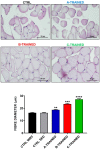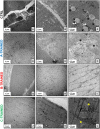Dose-Response Effect of Vibratory Stimulus on Synaptic and Muscle Plasticity in a Middle-Aged Murine Model
- PMID: 34177622
- PMCID: PMC8226218
- DOI: 10.3389/fphys.2021.678449
Dose-Response Effect of Vibratory Stimulus on Synaptic and Muscle Plasticity in a Middle-Aged Murine Model
Abstract
Whole body vibration plays a central role in many work categories and can represent a health risk to the musculoskeletal system and peripheral nervous system. However, studies in animal and human models have shown that vibratory training, experimentally and/or therapeutically induced, can exert beneficial effects on the whole body, as well as improve brain functioning and reduce cognitive decline related to the aging process. Since the effects of vibratory training depend on several factors, such as vibration frequency and vibration exposure time, in this work, we investigated whether the application of three different vibratory protocols could modulate synaptic and muscle plasticity in a middle-aged murine model, counteracting the onset of early symptoms linked to the aging process. To this end, we performed in vitro electrophysiological recordings of the field potential in the CA1 region of mouse hippocampal slices, as well as histomorphometric and ultrastructural analysis of muscle tissue by optic and transmission electron microscopy, respectively. Our results showed that protocols characterized by a low vibration frequency and/or a longer recovery time exert positive effects at both hippocampal and muscular level, and that these effects improve significantly by varying both parameters, with an action comparable with a dose-response effect. Thus, we suggested that vibratory training may be an effective strategy to counteract cognitive impairment, which is already present in the early stages of the aging process, and the onset of sarcopenia, which is closely related to a sedentary lifestyle. Future studies are needed to understand the underlying molecular mechanisms and to determine an optimal vibratory training protocol.
Keywords: hippocampus; mechanical vibration; muscle plasticity; synaptic plasticity; whole body vibration.
Copyright © 2021 Cariati, Bonanni, Annino, Scimeca, Bonanno, D’Arcangelo and Tancredi.
Conflict of interest statement
The authors declare that the research was conducted in the absence of any commercial or financial relationships that could be construed as a potential conflict of interest.
Figures



Similar articles
-
Modulation of Synaptic Plasticity by Vibratory Training in Young and Old Mice.Brain Sci. 2021 Jan 10;11(1):82. doi: 10.3390/brainsci11010082. Brain Sci. 2021. PMID: 33435131 Free PMC article.
-
Whole Body Vibration Improves Brain and Musculoskeletal Health by Modulating the Expression of Tissue-Specific Markers: FNDC5 as a Key Regulator of Vibration Adaptations.Int J Mol Sci. 2022 Sep 8;23(18):10388. doi: 10.3390/ijms231810388. Int J Mol Sci. 2022. PMID: 36142305 Free PMC article.
-
Hippocampal Adaptations to Continuous Aerobic Training: A Functional and Ultrastructural Evaluation in a Young Murine Model.J Funct Morphol Kinesiol. 2021 Dec 8;6(4):101. doi: 10.3390/jfmk6040101. J Funct Morphol Kinesiol. 2021. PMID: 34940510 Free PMC article.
-
Whole Body Vibration: A Valid Alternative Strategy to Exercise?J Funct Morphol Kinesiol. 2022 Nov 3;7(4):99. doi: 10.3390/jfmk7040099. J Funct Morphol Kinesiol. 2022. PMID: 36412761 Free PMC article. Review.
-
Acute and chronic neuromuscular adaptations to local vibration training.Eur J Appl Physiol. 2017 Oct;117(10):1939-1964. doi: 10.1007/s00421-017-3688-8. Epub 2017 Aug 1. Eur J Appl Physiol. 2017. PMID: 28766150 Review.
Cited by
-
Effects of whole-body vibration training in a cachectic C26 mouse model.Sci Rep. 2021 Nov 3;11(1):21563. doi: 10.1038/s41598-021-98665-7. Sci Rep. 2021. PMID: 34732809 Free PMC article.
-
Osteosarcopenia and Pain: Do We Have a Way Out?Biomedicines. 2023 Apr 26;11(5):1285. doi: 10.3390/biomedicines11051285. Biomedicines. 2023. PMID: 37238956 Free PMC article. Review.
-
Bone Adaptations to a Whole Body Vibration Protocol in Murine Models of Different Ages: A Preliminary Study on Structural Changes and Biomarker Evaluation.J Funct Morphol Kinesiol. 2025 Jan 10;10(1):26. doi: 10.3390/jfmk10010026. J Funct Morphol Kinesiol. 2025. PMID: 39846667 Free PMC article.
-
Targeting ERRs to counteract age-related muscle atrophy associated with physical inactivity: a pilot study.Front Physiol. 2025 Jul 7;16:1616693. doi: 10.3389/fphys.2025.1616693. eCollection 2025. Front Physiol. 2025. PMID: 40692696 Free PMC article.
-
Osteosarcopenia and Long-COVID: a dangerous combination.Ther Adv Musculoskelet Dis. 2022 Oct 26;14:1759720X221130485. doi: 10.1177/1759720X221130485. eCollection 2022. Ther Adv Musculoskelet Dis. 2022. PMID: 36317068 Free PMC article. Review.
References
LinkOut - more resources
Full Text Sources
Miscellaneous

